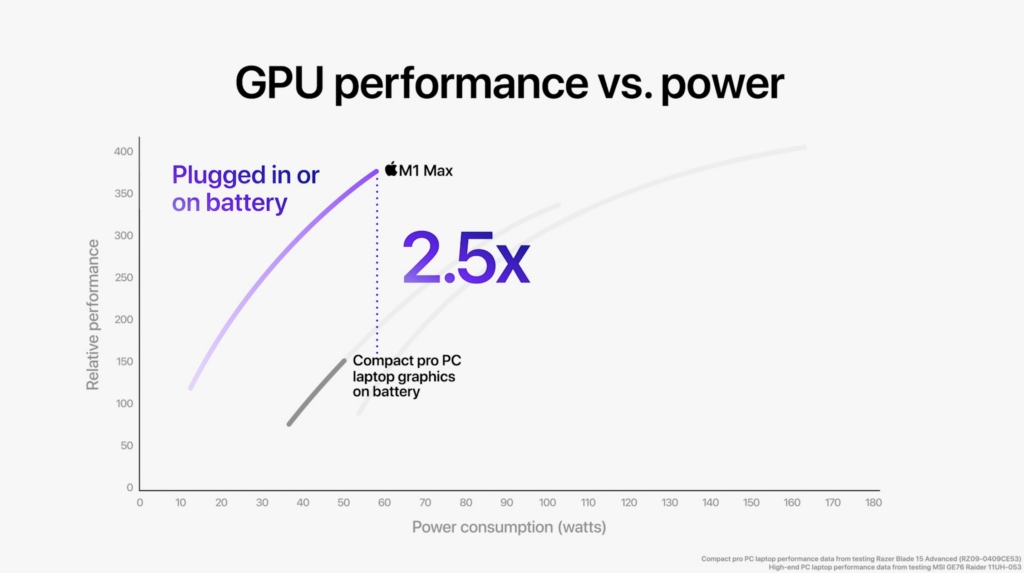Apple M1 Max: All the facts on ‘the world’s most powerful notebook chip’

Apple has unveiled a new M1 Max CPU it claims is “the world’s most powerful chip” for a notebook.
Here’s everything you need to know.
What is the Apple M1 Max chip?
The Apple M1 Max is currently the most powerful processor based on Apple Silicon. It’s still using the same 5nm architecture as the original M1 chip, but Apple has scaled up the number of transistors and cores in order to make it significantly more powerful.
The M1 Max is designed to deal with heavy workloads such as rendering 8K video and 3D animation. As such, it’s currently only available in the MacBook Pro laptop, although is expected to be fitted inside the Mac Mini and iMac next year.
Don’t expect it to remain as Apple’s most powerful chip though, as Apple expert Mark Gurman suggests the company is currently working on an even more powerful processor for the Mac Pro desktop.
Release date
The Apple M1 Max is confirmed to launch alongside the MacBook Pro on the 25 October 2021.
The chip is also expected to feature in other Mac devices in the future, but those are yet to be revealed. You’ll likely have to wait until 2022 if you want an M1 Max processor inside an iMac.
Price
The cheapest price you can find a 14-inch MacBook Pro with an M1 Max chip is £2799, which is a big price jump on the M1 Pro version.
Meanwhile, the entry price of the 16-inch MacBook Pro with a M1 Max chip costs £2999.
With such extravagant prices, you’ll really need to be sure you need the extra performance power of the M1 Max when purchasing it over the M1 Pro.
Specs
The Apple M1 Max is built on the same architecture as the original M1, which uses a 5nm manufacturing process. But it still offers a lot more power thanks to a larger number of transistors and cores.
It’s being pitched as the most powerful chip in Apple’s line for creative work, featuring the same 10 CPU cores as the M1 Pro, but with twice as many GPU cores with an impressive 32-core tally. Apple claims this enables it to offer 4x better graphics performance than the M1.
| Apple M1 | Apple M1 Pro | Apple M1 Max | |
| Transistors | 16 billion | 33.7 billion | 57 billion |
| High-performance CPU cores | 4 | Up to 8 | 8 |
| Energy-efficient CPU cores | 4 | 2 | 2 |
| GPU cores | Up to 8 | Up to 16 | 32 |
The M1X Max also supports 400gbps data bandwidth, which is six times than the original M1 and twice that of the M1 Pro. This will be a key metric for people that run demanding processes, like video editing, music creation and 3D modelling.
The chip houses 57 billion transistors, 1.7x more than the M1 Pro. It can also be configured with up to 64GB of memory, while the M1 Pro maxes out at 32GB.
Apple claims the M1 Max will deliver an “equivalent” graphics performance to competing laptop dGPUs while consuming 100W less power.

To find out how the two new chips compare check out our Apple M1 Max vs M1 Pro guide.
The Trusted Take
Apple’s decision to create a top-end CPU for creatives makes perfect sense. The firm’s always been a dominant force for designers, musicians, videographers, photographers and digital artists, so not having a CPU in its arsenal since ditching Intel was an odd omission.
Given how well the original M1 performed, I’m seriously keen to see if Apple’s performance claims ring true when we get the new MacBook Pro in for testing. If they do, I can see the new Pro being one of the best options for creatives and power users to arrive this year.





